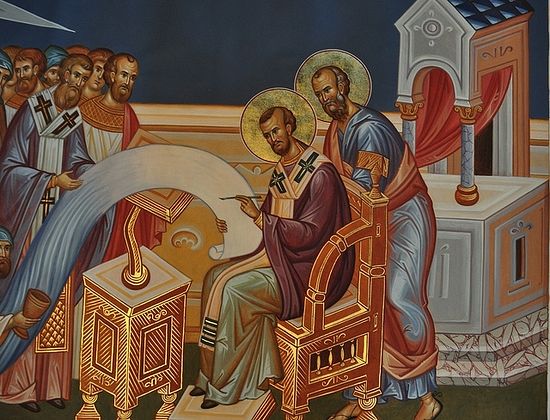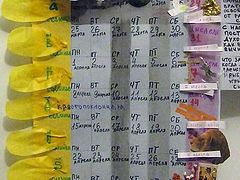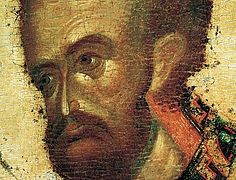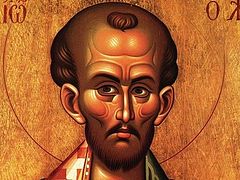 St. John Chrysostom and Apostle Paul
St. John Chrysostom and Apostle Paul
There are tons of pedagogical literature, both academic and popular. There are thick volumes with mixed-up directions, proven and unproven conclusions—with all manner of advice, methods, and principles. Some of these books are becoming table reference books for parents, and really help them in the difficult work of raising children. But many of them are in fact no more than abstruse bundles of words, behind which we no longer recognize our own child. Upbringing is all organized on shelves, in categories and subcategories, tables and graphs; and it’s all logical and comprehensible. Only it’s unclear what, or more exactly, who a child will grow up to be after all these pedagogical tricks. There is education, food, and various feeding methods. But upbringing? Formation of their image? And what image? We often miss such things. Sometimes people have to drink nothing but pure water in order to retrieve their natural taste—to return to their own real children from the swamp of that informational flood. We need to see them, themselves, emerging above the surface of our own daily anxieties and cares for their upbringing.
For me, that pure water is the reading of St. John Chrysostom. I especially love his explanation of the apostolic epistles and the Gospel according to St. Matthew. Somehow all I have to do is open his works to any page and I definitely find the answer to my immediate state. And no matter what happens, I only have to read one paragraph and everything becomes so much clearer and simpler.
St. John Chrysostom spoke very much about the family, especially in his homiletics (sermons that Priest John, and later Archbishop John gave in Antioch and Constantinople). He spoke even more about education. Reminders and digressions on these themes can be found in practically any of his homilies. But in the saint’s works are also particular homilies dedicated to the family and children.
We could write a small article that collects “everything St. John Chrysostom taught about the family and children”. But then things would be cited that are very important and profound, but pulled out of context. Sometimes such jerking out of context can lead to a total distortion of the author’s thoughts. In order to learn St. John Chrystostom’s teaching on the family and the upbringing of children you have to read his collected works.
When I was little, in my father’s office, standing in a neat row were the tall volumes of the complete works of St. John Chrysostom with gold letters on the covers. Despite my fertile imagination, I couldn’t conceive that an ordinary, “normal” person could read all of that. Taking such a volume into your hands seemed like an event from some abstract intellectual-spiritual world. And then to read it... My girlfriend once took (also from her father) one such volume. And on the next day she returned the book to her home library; it was just too hard to read. It would be better to read something contemporary. But to my mind, reading all twelve volumes from cover to cover was something so absolutely undoable that I didn’t even want to do it.
But in fact it’s only a matter of beginning to read. And not necessarily from the very beginning. Researchers divide the works of St. John Chrysostom into several periods. And they all divide them differently. This is in approximately the early and late periods. For us with families, most interesting is the saint’s homiletic period, when he taught ordinary laypeople; when he talks about the ordering of the ordinary person’s life. The saint applies every word of Holy Scripture, every parable to ordinary family life.
And he was not at all speaking to the ideal “Byzantine” Christian. Society at the time of St. John Chrysostom was in many ways similar to our modern world. There were huge cities in which there lived pagans, Jews, and Christians, people of many different nationalities, freemen and slaves, the very poor and the very rich. The traditions of Roman and Hellenic paganism were often mixed in with people’s everyday lives, people who were only second generation Christians. Christianity had only just begun to enter into society’s customs. Fornication and divorce, domestic violence and irresponsible parents, for whom entertainment and money were more valuable than children and families—these were the kinds of parents the saint was talking to. And the times and morals? Here is an illustration: In one of his early homilies the saint advises parents against sending their children to school, not at all because he was against secular education as such, but because very often educational institutions were hothouses of “love for boys”. Sixteen centuries have passed since then, but we are not living in either better or the worse conditions than St. Chrysostom’s listeners. True, they had the opportunity to come to church and hear a man whom the Orthodox Church has glorified as a great ecumenical teacher and saint. But we too can come to the very same churches and hear the words of sermons. We too can hear that same Chrysostom, by reading and re-reading his works.
 We can begin by reading those sermons in which St. John Chrysostom talks about the family and children. There aren’t so many of them. Yes, and my girlfriend by the way, for whom the texts of Chrysostom seemed to heavy, tried again after a while to read the saint’s words and now she returns to him over and over. This is because she simply opened the book to a certain place—she read into it, and fell in love with the peculiar but very colorful language of one of the most outstanding preachers “of all times and peoples”. You only have to begin reading and you won’t be able to tear yourself away; it will become a necessity.
We can begin by reading those sermons in which St. John Chrysostom talks about the family and children. There aren’t so many of them. Yes, and my girlfriend by the way, for whom the texts of Chrysostom seemed to heavy, tried again after a while to read the saint’s words and now she returns to him over and over. This is because she simply opened the book to a certain place—she read into it, and fell in love with the peculiar but very colorful language of one of the most outstanding preachers “of all times and peoples”. You only have to begin reading and you won’t be able to tear yourself away; it will become a necessity.
[In Russian] the complete works of St. John Chrysostom can be found on the Internet [much can be found in English as well[1]], so this reading is accessible to all. But it is better to have “living” books—to make pencil marks in those places that seem important. You can write your thoughts in the margins about what you’ve read. And then you can return to those texts. And then other family members will take the book in their hands and see what previous readers noted.
First I’ll tell you about the works of St. John Chrysostom in which the family and upbringing of children are the main theme. They are:
1. Five homilies on Anna. De Anna sermones.[2]
Here the saint looks at the story of the prophetess Anna, mother of Prophet Samuel. Anna’s relationship to her child is an example for every father and every mother. Chrysostom talks in detail about this relationship. What two “silent teachers” do we have from the beginning? Who is given to us “by God’s Providence” as a third teacher? What does it mean to dedicate your child to God? How can we lead our child from an early age into “heavenly life”? The saint poses these questions and thoroughly answers them. He tells how any mother can become a royal temple, how Anna competes with the patriarch Abraham in zeal and honors her little son, how parents care daily for their children.
The ability to give birth has its beginning from above—from God’s Providence, and... for this neither women’s nature, nor cohabitation with a husband or anything else is sufficient by itself (Five homilies on Anna, 1).
2. Discourse on the words: Let not a widow be taken into the number under threescore years old (1 Tim. 5:9), on the upbringing of children, and on almsgiving In illud: Vidua eligatur.
Chrysostom begins this discourse with what is said about widows (true widows), about second marriages, and marriage in general. He discusses the relationship of a new wife to the memory of the former one. And he gradually transitions to the theme of raising children; here he no longer talks about widows but about parents. Moreover the saint first addresses the father and not the mother. He calls those who do not give their children a proper upbringing infanticides, asserting that by not giving them any upbringing, we destroy the whole world, no more no less.
What authority God has given to the father, and what means has he given to enforce it? What is the measure of parental responsibility for the child? How is honor for parents correlated with our relationship to God? Where should children receive a “religious education”? What about a married woman? How could it happen that a father betrays his own children? Why do many parents only wake up to the need to bring up their children only when the latter are practically grown up and the law enforcement officers have come for them? This and much more can be learned in this discourse.
If you bring up your son excellently, then he will do the same for his son, and his son in turn for his own son; and it will be as if a certain chain and series of better lives will go forward, having received a beginning and root from you and bringing you the fruits of your care for your descendants (Discourse on the widow).
3. Discourse 20 from “Discourses on the Epistle to the Ephesians”
In epistulam ad Ephesios argumentum et homiliae 1-24; CPG, N 4431; PG. 62. Col. 9-176.
Here St. John Chrysostom explains the fifth chapter of the Epistle of Apostle Paul to the Ephesians, in which he talks about marriage. You can read this discourse in total, and then reread it little by little, line-by-line, a paragraph a day, striving to take it in and understand what the saint is saying. It is one of the first clearly formulated, detailed Christian teachings on family. And it remains as the foundation of all the teachings of our Orthodox Church to follow on the little Church [—the family]. This discourse should definitely be read before entering into marriage, during every marital conflict—best when the conflict is just beginning to ripen. It should be read at every wedding anniversary, and then those anniversaries will be much more meaningful than they often are in our society.
Discussed in the discourse is the unanimity between the spouses as the main condition for peace in the world and the good upbringing of children. It talks about how the wife submits to the husband and at the same time, how the husband loves his wife, and in what ways he teaches her obedience. About what to do with his wife’s failings. About fleshly and spiritual union in marriage. About the ideal relationship of mutual respect, patience, and obedience. And again, about love and oneness of mind in marriage. On prayer at home. It is here that the saint emphasizes that the home is a small Church (the word is capitalized in the original Greek).
The husband brings her into submission and is above her, precisely so that there would be peace. There can be no peace where there is equality, be it in state governance or if all should command—there must be a ruler (Discourse 20 on the Epistle to the Ephesians).
What other questions does Chrysostom answer here? What does it mean to leave your wife or husband in order to follow Christ? What should the husband do if the wife is depraved and despises her husband? What should one spouse do if the other does not fulfill his or her duty? What is a spiritual marriage? What does it mean to “fear the husband”? What significance does money have for marital relations? What place does the husband occupy in marital life? What place does the wife occupy in the social and spiritual life of her husband? How should family possessions be divided? There are even words on the inner disposition of a newly wed Christian.
Do not only just call her, but do it with affection, honor, and great love. Respect her, and she will not feel the need for respect from others, she will not need the approval of others if she enjoys your respect and approval. Prefer her over all others, in all respects—praise her with regard to both beauty and wisdom (Discourse 20 on the Epistle to the Ephesians).
4. Discourse 21 from “Discourse on the Epistle to the Ephesians”
In epistulam ad Ephesios argumentum et homiliae 1-24; CPG, N 4431; PG. 62. Col. 9-176
This discourse is a continuation of Discourse 20, only now particularly on the upbringing of children. A conversation begins again on the theme of married life: If the husband and wife will be true to what was laid out in the previous discourse, then the children will also be in submission to Divine law. The saint briefly speaks of the children’s duty with respect to their parents, and more explicitly on the parents’ obligations. It talks about the main cause of children’s disobedience to their parents, how to make the child a Christian, and who is obligated to make this happen. What does it mean to entrust your child to God? Who should bring up the children in the correction and teachings of the Lord? What does “practical education” mean?
He also speaks of the particularities of the values system of Christian education, about the interrelationship of this true education with the outward, secular systems. And about how true education enables career growth, and a brilliant secular education without a true education engenders extreme need while yet in earthly life. About how the path to the Kingdom of Heaven for the husband and father is bound up with the “education and good ordering”[3] of the wife and children. And also about whether God will help us parents in the upbringing of our children if we pray but do not labor over their upbringing. Or if we labor, but do not turn to Him.
If he whose children are unruly is not worthy of a bishopric, then even less so is he worthy of the Kingdom of Heaven (Discourse 20 on the Epistle to the Ephesians).
5. Treatise “On ambition and about how parents must bring up their children”
Περ κενοδοξίας κα ὅπως δεῖ τοὺς ϒονέας ἀνατρέφειν τὰ τέκνα; De inani gloria et de educandis liberis; CPG, N 4455; SC. 188
This text is not so accessible as the previous one, and has almost a detective-like publication history. But for that it is no less interesting, especially for parents. It is inaccessible [in Russian] because it is hard to find in the compilation of the complete works of St. John Chrysostom that was published in the Russian Empire in the late nineteenth century, from which all reprints were made in post-soviet Russia. The problem is that the translation of a more or less complete collection of Chrysostom’s works in Russian was prepared only at the end of the nineteenth century through the efforts of students at the St. Petersburg Theological Academy. Before that, we had separate works or anthologies compiled from various texts. This translation, which we use to this day, was made from the “Greek Patrology” of Abbot Minya (at the time it was the most complete collection of texts). And Abbot Minya did not include this very treatise, “On the Upbringing of Children”, in his Patrology, neither in the section of authentic, nor in the disputed works of the saint. And this treatise does not exist in the Russian collection.[4]
Today this text is considered to be the authentic work of Chrysostom and is used as one of the main works by the saint on the upbringing of children.[5] The treatise has been translated into modern Greek in the publication of the Greek Fathers of the Church (Έλληνες Πατέρες της Εκκλησίας. Τ. 30), and is used by Greek Orthodox priests to describe Chrysostom’s pedagogical teachings.[6] In 1990 a translation of this treatise appeared in Russian,[7] can be downloaded from the Internet or read in libraries. Let’s take a look at how this treatise can help us parents in the upbringing of our own children. After all, in any case, this text is dedicated particularly to Christian care for the child.
Here we can also find very figurative value systems, by which Christian parents should be guided. But the main thing is the quite workable practical recommendations for the upbringing of a “struggler for Christ” and “citizen of Heaven”.
For example, here is what really inspires me. In many of his homilies, St. John Chrysostom calls upon parents to teach their children Holy Scripture. And in this treatise is thoroughly explained how this can be done in practice. During family dinners, the father can retell the story of Cain and Abel in his own words. It is shown how this retelling can be prepared. The Mother sits next to him and listens approvingly to the father’s words along with the children. The father, and later the mother explain the meaning of the Bible story. During the next meal the father asks the child what he remembers from yesterday’s story—a repetition of the foregoing. And the father again explains the moral of the Biblical brothers’ relationship. Then comes the conclusive step of this domestic lesson, drawn out over several days: The father takes the child by the hand, leads him to the church that day, when that same story is read in the church. “And then the matter is impressed in the child’s memory for the future,” says the saint. This is an example of religious education that takes place in the small Church and the greater Church at the same time.
The treatise talks about the teaching of chasteness in the same understandable and quite applicable way for the life of a family in the twenty-first century, from the earliest age. Here we can read about the gates to a child’s soul and how to guard those gates. About the meaning of the sculptor and king in the upbringing of children. About the benefit of young people’s association with monks and bishops. About the relationship of the child to his younger brothers as a school of controlling one’s own feelings. On prayer and fasting for a child. And on how in bringing up their children, parents can create a golden chain for their descendants. And also, of course, about weddings:
Now everyone exerts all efforts to teach their children crafts, sciences, and rhetoric, and no one takes time to adorn their souls. I will not cease to appease you, ask and beg that you take care to order your children before all other important matters (Discourse “On Ambition, and how parents should bring up their children).
There are of course many other homilies by the saint in which Chrysostom teaches us about family life, teaches parents the “education and ordering” of children. It is not always easy to find such passages because they are often hidden within some “mature” text. For example, in his Explanation of the Gospel of Matthew, the saint talks about the fig tree (Discourse 77). He talks about the end of time, about love and alms, fulfilling God’s will, about the need to take care of our neighbors. This care can be of many different kinds, including: “Each one of us has a lamb, which we are obligated to lead to a good pasture. The husband as he rises from his bed should strive only for this—to by words and deeds plant more piety in his home and family. By the same token his wife look after the home, but she should also have another, more real care that the whole family should labor for the Kingdom of Heaven.” There you have it, just one phrase, but it’s a whole lesson. It’s worth it to read it and think about it...
I’ll note that if we read prepared collections “on the upbringing of children” we can find vast citations about how teachers should teach the young generation. After checking them we can see that that the saint was not at all directing these words to teachers, and they are not about children. The saint is addressing priests, who are the teachers of those adults who come to church. Or, it is about the catechism of adults. Therefore I repeat it again and again: We ourselves have to read the texts of the great universal teacher and holy hierarch, St. John Chrysostom.
In conclusion we must definitely mention also those works by St. John Chrysostom in which the theme of family and the upbringing of children are not the main theme, but run like a golden thread throughout many texts:
6. Eight homilies on the Book of Genesis.[8] Especially: Homily 4 on the origin of the husband’s authority over the wife; on the authority of parents over the children; homily 5 on the wife who has an unfaithful husband. At the end of the final two discourses are the saint’s thoughts on family dinners.
7. Discourses on the holy Evangelist Matthew. In almost every discourse you can learn about family life and the upbringing of children. Discourse 11 on spiritual education in the family, discourse 60 on curbing children’s uruliness, discourse 17 and 62 on love in marriage, and on divorce as lawlessness and equal to adultery.
8. Discourse on the holy Apostle and Evangelist John.
9. Explanation of the Epistle to the Romans.
10. Discourses on the First and Second Epistle to the Corinthians. Especially: Discourse 19 on disinclination from marital cohabitation, on love, oneness of mind between spouses, and the terrible consequences spousal conflicts. The saint clearly and at times unexpectedly talks about the real causes of the breakup of Christian families. Discourse 26 on the wife’s obedience and submission to her husband, and on a husband’s lawlessness and madness if he strikes his wife.
11. Explanation of the psalms. For example, on Psalm 41. On how to make your home a Church and on common family prayer, or on Psalm 43, where the parents teach their children Scripture.
12. Discourses on the Epistle to Titus. Especially 2 and 4 about what it means exactly to be chaste, and on love and hierarchy in relations between husband and wife.
13. Discourses on the Epistle to the Colossians. Especially: Discourse 7 on the sickness and death of a child, discourse 10 on love and submission in marriage, on when it is necessary to give in to your children, and on the beauty of the wife. Discourse 12 is a veritable hymn to marriage, which talks about the cohabitation of spouses, on conception, birth and upbringing of children, and on weddings.
14. Discourses on the Acts of the Apostles.
15. Discourses on the First and Second Epistles to Timothy. Especially: Discourse 9, in which is discussed the woman’s path of salvation, and the cultivation of restraint.



